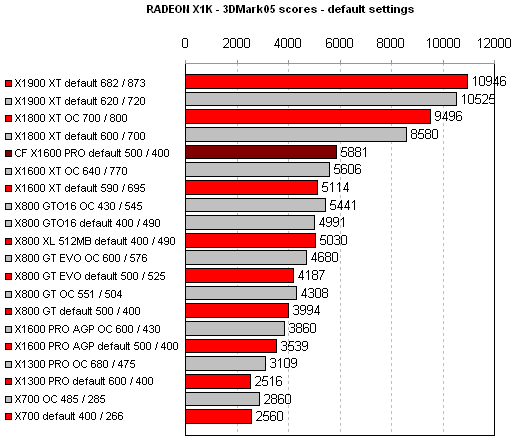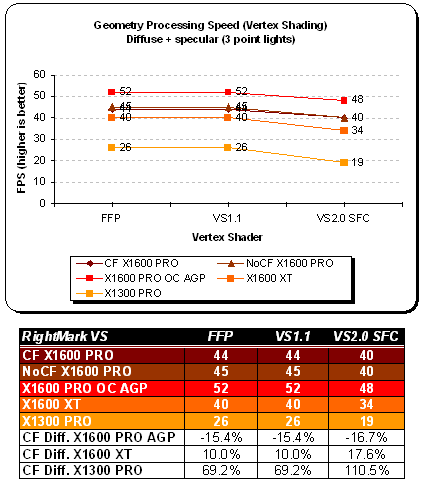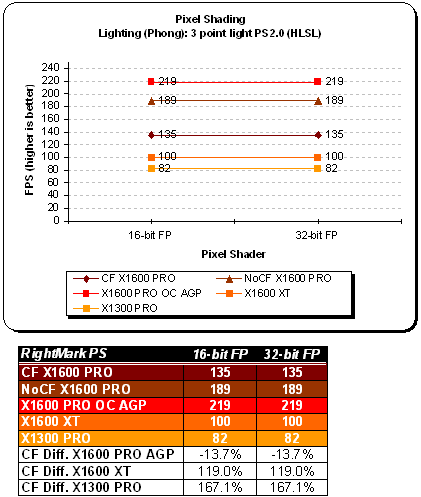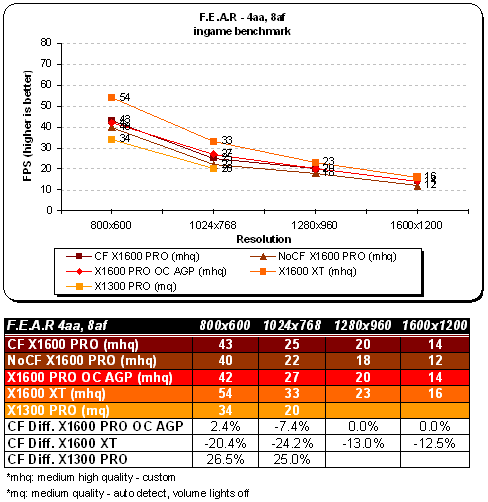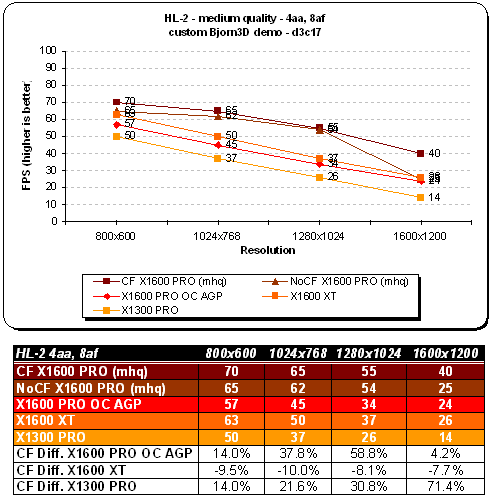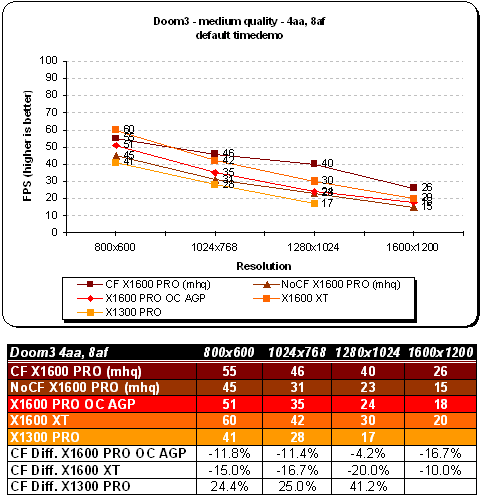With no need for master card, this solution may be good for those seeking less expensive graphics parts and no additional bonding media such as compositing cable. I, however do not recommend the mainboard I was testing those samples on simply because it doesn’t seem ready and as for overclocking, it’s close to nonexistent.
Introduction
Crossfire and SLI are a hot topic for gamers and enthusiasts. Last month I took a look at PowerColor X1600 PRO AGP. Not only you can get it for as low as $139, but it comes with 512 MBs of RAM. Just about a week ago, Bjorn took at a look at a similar setup I have today: HIS X1600 PRO IceQ Turbo Crossfire. Obviously not everyone can afford a top of the line Crossfire / SLI setup, but owning a mid-end combo should also give you a good performance kick.
Looking at PowerColor cards most of the time, I’ve decided to check out what competition has been cooking around. Does Sapphire X1600 PRO Crossfire edition sound any good? Well it should be as it’s in my lab today and I promise to give you guys a good insight on it.
The good thing is neither the cards use compositing chip which eliminates the need for a master card and additional cabling — exactly the opposite when it comes to high-end stuff like RADEON X1800 / X1900.
A pair of X1600 PROs combined with ATI’s new Xpress 3200 motherboard chipset make it a nice combo for as little as 320 green. It’s not necessarily a flawless solution, but for entry level Crossfire setup it’s decent.
As for Sapphire, they are the biggest ATI customer and are their key graphics boards supplier, just so you know
Captured within the circuitry of each of SAPPHIRE’s graphic cards and mainboards can be found the collective feedback from generations of enthusiasts in every market niche. Brought to life through performance oriented innovation and an emphasis on quality control, SAPPHIRE designs, manufactures and distributes the most complete range of ATI video boards and mainboards–from the mainstream products that afford the casual user the opportunity to enjoy enriched graphics and affordable platform solutions to the state-of-the-art technological marvels that drive fantasies to before unattainable thresholds of realism, and offer the pinnacle of stability and performance! SAPPHIRE refuses to compromise quality by cutting corners at the expense of its customers experience with their products.VPU Specifications
As with every new generation of GPUs the feature set becomes larger and more complex. The newly introduced X1K family of products is exactly what we have here. Most importantly, the X1000 line now sports Shader Model 3.0 which has been available from NVIDIA for over a year now. The X1600 GPU is similarly designed as X1800, but with few important differences. It uses 128-bit memory bus and features different pipeline architecture. The card boasts 4 pipelines (known as ROPs, Render Output Pipelines). Do not get confused (as I did), I’ll explain.
ROPs are actual pixel pipelines. Shader pipelines or pixel shaders consist of ROPs and fragment pipelines. With X1600, each ROP consists of 3 pixel shaders (giving us 12 PS units) and 8 Z-samples per clock. In other words X1600’s pipeline configuration is as follows:
- 12 PS units
- 4 ROPs
- 4 TMUs (1 TMU per pipeline)
- 8 Z-samples per clock
The biggest of all changes is the introduction of what ATi calls Ultra-Threading Dispatch Processor and Ring Bus (old SMARTSHADER). Without going into much detail here, the dispatch processor (as the name implies) routes or relegates the workload to four pixel shader cores (also known as Quads). Each quad consists of four mini-pixel processors. The process between them is called threading and means:
- Large Scale Multi-threading
- Hundreds of simultaneous threads across multiple cores
- Each thread can perform up to 6 different shader instructions on 4 pixels per clock cycle
- Small Thread sizes
- 16 pixels per thread in Radeon X1800
- Fine-grain parallelism
- Fast Branch Execution
- Dedicated units handle flow control with no ALU overhead
- Large Multi-Ported Register arrays
- Enables fast thread switching
Now the Ring Bus technology. This isn’t Marry-go-around or anything like that — well sort of. The bus itself consists of two 128-bit rings which run in the opposite direction. This way routing latencies are reduced to a bare minimum and clockrate scaling is far more efficient. Among other things we have:
- New cache design – fully associative for more optimal performance
- Improved Hyper-Z – better compression and hidden surface removal
- Programmable arbitration logic – maximizes memory efficiency and can be upgraded via software
| Video card |
Sapphire X1600 PRO | PowerColor X1600 XT | PowerColor X1300 |
| GPU (256-bit) | RV530 | RV530 | RV515 |
| Chip Architecture | .09µ (TSMC fab) | .09µ (TSMC fab) | .09µ (TSMC fab) |
| Transistors | ~157 Million | ~157 Million | ~100 Million |
| Memory Architecture | 128-bit | 128-bit | 128-bit |
| Frame Buffer Size | 256 MB GDDR-2 | 256 MB GDDR-2 | 256 MB GDDR-3 |
| Pixel Pipelines* | 4 / 4 / 8 | 4 / 4 / 8 | 4 / 4 / 4 |
| Vertex Pipelines | 5 | 5 | 2 |
| TMU(s) per Pipeline | 1 | 1 | 1 |
| Engine | Ultra-threaded | Ultra-threaded | Ultra-threaded |
| Bus Type | PCI-e 16x | PCI-e 16x | PCI-e 16x |
| Core Clock | 500 MHz | 590 MHz | 600 MHz |
| Memory Clock | 800 MHz DDR | 1380 MHz DDR | 800 MHz DDR |
| RAMDACs | 2x 400 MHz DACs | 2x 400 MHz DACs | 2x 400 MHz DACs |
| Memory Bandwidth | 12.8 GB / sec | 22.1 GB / sec | 12.8 GB / sec |
| Pixel Fillrate | 2.0 GPixels / sec | 2.36 GPixels / sec | 2.4 GPixels / sec |
| Texel Fillrate | 2.0 GTexels / sec | 2.36 GTexels / sec | 2.4 GTexels / sec |
| DirectX Version | 9.0c | 9.0c | 9.0c |
| Pixel Shader | 3.0 | 3.0 | 3.0 |
| Vertex Shader | 3.0 | 3.0 | 3.0 |
* Pipeline architecture: Textures / Pixels / Z-Samples per clock
X1600 Specifications
- Features
-
- 157 million transistors on 90nm fabrication process
- Dual-link DVI
- Twelve pixel shader processors
- Five vertex shader processors
- 128-bit 4-channel DDR/DDR2/GDDR3 memory interface
- Native PCI Express x16 bus interface
- AGP 8x configurations also supported with AGP-PCI-E external bridge chip
- Dynamic Voltage Control
- Ring Bus Memory Controller
-
- 256-bit internal ring bus for memory reads
- Programmable intelligent arbitration logic
- Fully associative texture, color, and Z/stencil cache designs
- Hierarchical Z-buffer with Early Z test
- Lossless Z Compression (up to 48:1)
- Fast Z-Buffer Clear
- Z/stencil cache optimized for real-time shadow rendering
- Ultra-Threaded Shader Engine
-
- Support for Microsoft® DirectX® 9.0 Shader Model 3.0 programmable vertex and pixel shaders in hardware
- Full speed 128-bit floating point processing for all shader operations
- Up to 128 simultaneous pixel threads
- Dedicated branch execution units for high performance dynamic branching and flow control
- Dedicated texture address units for improved efficiency
- 3Dc+ texture compression
- High quality 4:1 compression for normal maps and two-channel data formats
- High quality 2:1 compression for luminance maps and single-channel data formats
- Multiple Render Target (MRT) support
- Render to vertex buffer support
- Complete feature set also supported in OpenGL® 2.0
- Advanced Image Quality Features
-
- 64-bit floating point HDR rendering supported throughout the pipeline
- Includes support for blending and multi-sample anti-aliasing
- 32-bit integer HDR (10:10:10:2) format supported throughout the pipeline
- Includes support for blending and multi-sample anti-aliasing
- 2x/4x/6x Anti-Aliasing modes
- Multi-sample algorithm with gamma correction, programmable sparse sample patterns, and centroid sampling
- New Adaptive Anti-Aliasing feature with Performance and Quality modes
- Temporal Anti-Aliasing mode
- Lossless Color Compression (up to 6:1) at all resolutions, including widescreen HDTV resolutions
- 2x/4x/8x/16x Anisotropic Filtering modes
- Up to 128-tap texture filtering
- Adaptive algorithm with Performance and Quality options
- High resolution texture support (up to 4k x 4k)
- 64-bit floating point HDR rendering supported throughout the pipeline
- Avivo™ Video and Display Platform
-
- High performance programmable video processor
- Accelerated MPEG-2, MPEG-4, DivX, WMV9, VC-1, and H.264 decoding and transcoding
- DXVA support
- De-blocking and noise reduction filtering
- Motion compensation, IDCT, DCT and color space conversion
- Vector adaptive per-pixel de-interlacing
- 3:2 pulldown (frame rate conversion)
- Seamless integration of pixel shaders with video in real time
- HDR tone mapping acceleration
- Maps any input format to 10 bit per channel output
- Flexible display support
- DVI 1.0 compliant / HDMI interoperable and HDCP ready
- Dual integrated 10 bit per channel 400 MHz DACs
- 16 bit per channel floating point HDR and 10 bit per channel DVI output
- Programmable piecewise linear gamma correction, color correction, and color space conversion (10 bits per color)
- Complete, independent color controls and video overlays for each display
- High quality pre- and post-scaling engines, with underscan support for all outputs
- Content-adaptive de-flicker filtering for interlaced displays
- Xilleon™ TV encoder for high quality analog output
- YPrPb component output for direct drive of HDTV displays*
- Spatial/temporal dithering enables 10-bit color quality on 8-bit and 6-bit displays
- Fast, glitch-free mode switching
- VGA mode support on all outputs
- Drive two displays simultaneously with independent resolutions and refresh rates
- Compatible with ATI TV/Video encoder products, including Theater 550
- High performance programmable video processor
- CrossFire™
-
- Multi-GPU technology
- Four modes of operation:
- Alternate Frame Rendering (maximum performance)
- Supertiling (optimal load-balancing)
- Scissor (compatibility)
- Super AA 8x/10x/12x/14x (maximum image quality)
The Card
This board is standard size PCB though heatsink is much different than on PowerColor X1600 PRO AGP. Again as with any X1600 it’s an ideal solution for HTCP and SFF systems where space and good ventilation is your number 1 priority. This particular setup is rather loud when combined having two cards in such system maybe a pain in the brain…sort of.
Click a picture to see a larger view
Sapphire had always made sure their cards stand up from the crowd. For mid and low ends they modify PCB color, slap some nonstandard HSF and put a Sapphire sticker — this is something PowerColor does not do, they use stock-everything. The board sports a VGA port, dual DVI link, S-video and 256 MBs of onboard GDDR2 RAM from Hynix (HY5PS561621AFP-25, 16 Mbit x 16 DDR2, 400 MHz, FBGA)
You can also see it how it fits into Sapphire PC-A9RD580Adv mainboard based on Xpress 3200 chipset. Looks neat right?
Bundle
You won’t get anything interesting with this X1600 PRO card, mostly cables, connectors and drivers. The bundle of course does not include the motherboard, but it would be interesting to see shops selling combos like those. Because I’ve got a sample it did not come in a fancy Sapphire box, instead a brown ugly carton :/
Click a picture to see a larger view
Accessories
- Composite cable
- HDTV Cable
- S-Video cable
- S-Video to AV Adapter
- DVI-I connector
Software
- ATI drivers
Setup and Installation
For testing purposes I’ve used Sapphire PC-A9RD580ADV motherboard and I actually regret it. It’s based on ATI’s new Xpress 3200 chipset, has plenty of features, but no overclocking potential at all due to BIOS issues. The non advantage mobo (white PCB) supposedly has a much better BIOS and can compete with ASUS and DFI. All my previous tests were ran on an overclocked CPU (2.5GHz) and getting this Venice to even 2.0GHz was a major struggle.
After trying out different options I swapped the BIOS, but with no further luck; changed HTT a little, dropped LTD, reboot and no go. This BIOS did not even have VDIMM settings geeee go wonder…I gave up and used default clocks which are 1.8GHz. This will give this Sapphire setup a much lower scores than expected so please bear this in mind.
| Components | – Sapphire PC-A9RD580Adv – Athlon 64 3000+ (Venice) – G.Skill F1-4000BIU2-2GBHV DDR500 – Thermaltake ToughPower 550W – Sapphire X1600 PRO Crossfire / Single – PowerColor X1600 PRO AGP 512MB – PowerColor X1600 XT – PowerColor X1300 |
| Software | – Windows XP SP2 – DirectX 9.0c – CATALYST 6.4 |
| Synthetic Benchmarks | – 3DMark 2005 v1.2.0 – D3D Right Mark 1.0.5.0 beta 4 |
| Gaming Benchmarks | – F.E.A.R / ingame benchmark + Fraps – Half-Life 2 / custom d13c17 timedemo + Fraps – Doom 3 / default timedemo + Fraps – NFS: Most Wanted / Fraps |
| Notes | default CPU clock |
Installation went smoothly. Just popped the cards in and turned it on. A loud sound came out of of the two cards’ fans, but it died down afer two seconds or so. Later on I’ve noticed this isn’t the softest solution for your ear, might get ear plugs or something. Anyway, above you have system specs and benchmark notes for you to look at.3DMark05
I’ve used Futuremark’s 3DMark 2005 to measure the actual throughput of Sapphire X1600 PRO Crossfire and compared it against a few other RADEONs: X1600 PRO AGP OC, X1600 XT and X1300.
| Video card |
X1600 PRO CF | X1600 PRO OC |
X1600 XT | X1300 |
| Pixel Fillrate | 2241 MPixels /sec | 1248,6 MPixels /sec | 2055,2 MPixels /sec |
1017,5 MPixels / sec |
| Texel Fillrate | 3546 MTexels / sec | 2405,1 MTexels / sec | 2351,6 MTexels / sec |
1689,3 MTexels / sec |
| Geometry Rate | 500 MTriangles | 600 MTriangles | 590 MTriangles |
600 MTriangles |
| VS – Simple | 93 MVertices / sec | 50,1 MVertices / sec | 73,2 MVertices / sec |
45,2 MVertices / sec |
| VS – Complex | 43,3 MVertices / sec | 39,9 MVertices / sec | 47,1 MVertices / sec | 15,7 MVertices / sec |
| PS (2.0b) | 115,3 FPS | 105.7 FPS | 113,4 FPS |
33,5 FPS |
Let’s have a look at game test scores as those are more interesting to look at.
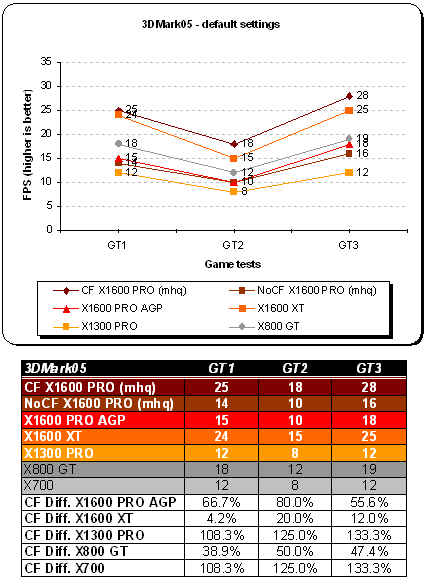
With D3D RightMark you will be able to get the following information about your video card:
- Features supported by your video card
- Pixel Fillrate and Texel Fillrate
- Pixel shader processing speed (all shader models)
- Vertex shader (geometry) processing speed (all shader models)
- Point sprites drawing speed
- HSR efficency
F.E.A.R
Game Overview
An unidentified paramilitary force infiltrates a multi-billion dollar aerospace compound, taking hostages but issuing no demands. The government responds by sending in special forces, but loses contact as an eerie signal interrupts radio communications. When the interference subsides moments later, the team has been obliterated. As part of a classified strike team created to deal with threats no one else can handle, your mission is simple: Eliminate the intruders at any cost. Determine the origin of the signal. And contain the crisis before it spirals out of control.
As you probably know, F.E.A.R uses a very sophisticated game engine (FEAR).
- Rendering
- FEAR is powered by a new flexible, extensible, and data driven DirectX 9 renderer that uses materials for rendering all visual objects. Each material associates an HLSL shader with artist-editable parameters used for rendering, including texture maps (normal, specular, emissive, etc.), colors, and numeric constants.
- Lightning Model
- FEAR features a unified Blinn-Phong per-pixel lighting model, allowing each light to generate both diffuse and specular lighting consistently across all solid objects in the environment. The lighting pipeline uses the following passes:
- Emissive: The emissive pass allows objects to display a glow effect and establishes the depth buffer to improve performance.
- Lighting: The lighting pass renders each light, first by generating shadows and then by applying the lighting onto any pixels that are visible and not shadowed.
- Translucency: The translucent pass blends all translucent objects into the scene using back to front sorting.
- FEAR features a unified Blinn-Phong per-pixel lighting model, allowing each light to generate both diffuse and specular lighting consistently across all solid objects in the environment. The lighting pipeline uses the following passes:
- Visual Effects
- FEAR features a new optimized, data driven effects system that allows for the creation of key-framed effects that can be comprised of dynamic lights, particle systems, models, and sounds. Examples of the effects that can be created using this system include weapon muzzle flashes, explosions, footsteps, fire, snow, steam, smoke, dust, and debris.
- Sample Lights
- FEAR’s lighting model is very flexible and allows developers to easily add new lights. Existing lights include:
- Point Light: The point light is a single point that emits light equally in all directions.
- Spotlight: Similar to a flashlight, the spotlight projects light within a specified field of view. The spotlight can also use a texture to tint the color of the lighting on a per pixel basis.
- Cube Projector: Similar to the point light, the cube projector uses a cubic texture to tint each lit pixel.
- Directional Light: This lighting is emitted from a rectangular plane and is used to simulate directional lights like sunlight.
- Point Fill: Although similar to the point light, the point fill is an efficient option because it does not utilize specular lighting or cast shadows.
- FEAR’s lighting model is very flexible and allows developers to easily add new lights. Existing lights include:
A more detailed overview of other F.E.A.R technologies can be found over at Touchdown Entertainment. These include: Havok Physics Engine and Modeling / Animations System.
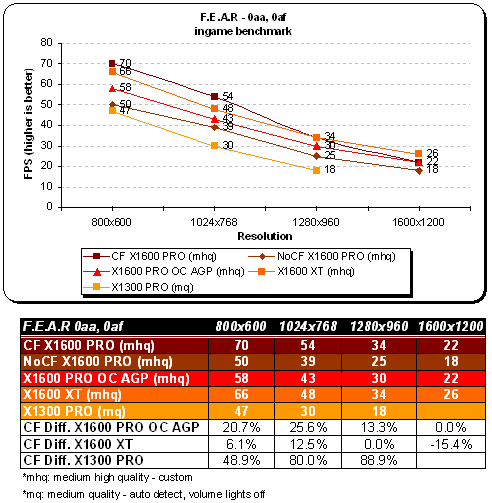
Half-Life 2
We all love Half-Life 2 and we all want best performance out of our hardware. This has to be one of the most graphic demanding games currently on the market. Half-Life 2 is built around Source engine which utilizes a very wide range of DirectX 8 / 9 special effects. Those include:
- Diffuse / specular bump mapping
- Dynamic soft shadows
- Localized / global valumetric fog
- Dynamic refraction
- High Level-of-Detail (LOD)
Note that users with DirectX 7 and older hardware (NVIDIA MX series for example) will not be able to enjoy the above effects. Let’s see how middle-end / low-end X1K graphic cards perform.
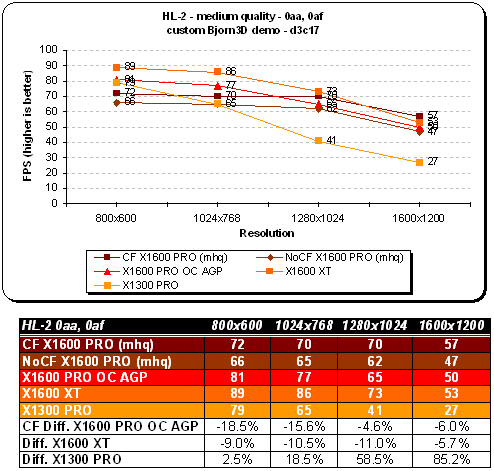
Doom 3
Although this game needs no introduction, I will go over some of the game features and technology behind Doom 3. It took the guys at id Software over four years to complete this project. Lead programmer, John Carmack spent an awful lot of time designing the game engine, but his hard work paid off — to some extent since this is first title which houses Doom 3 engine.
Let’s look at some of the engine tech features which are present in Doom 3:
- Unified lightning and shadowing engine
- Dynamic per-pixel lightning
- Stencil shadowing
- Specular lightning
- Realistic bumpmapping
- Dynamic and ambient six-channel audio
However you look at it, Carmack’s lightning engine is the essence of Doom 3. With OpenGL being the primary API, shaders have been put to a heavy use in order to create the realisticly looking environment. Instead of using lightmaps the game engine now processes all shadows in real-time. This technique is called stencil shadowing which can accurately shadow other objects in the scene. There are disadvantage to this method however:
- Requires a lot of fillrate
- Fast CPU is needed for shadow calculations
- Inability to render soft shadows
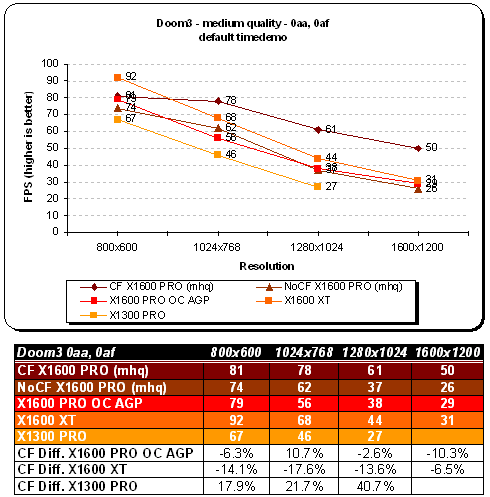
Need For Speed: Most Wanted
We have quite a few sequels in this review and this is another one, this time from Electronic Arts. If you’ve played NFS Hot Pursuit you know what I’m talking about. There are a lot of ideas taken out from the older NFS. The main difference between Most Wanted and Underground (in terms of graphics) is addition of HDR-type effects. It’s pseudo-HDR (more like bloom), but looks lovely nonetheless. Additionally the game sports flashy new reflections, better object geometry, improved lightning system and finally physics engine.
Here we have a fresh new title with bells and whistles waiting to get benched.
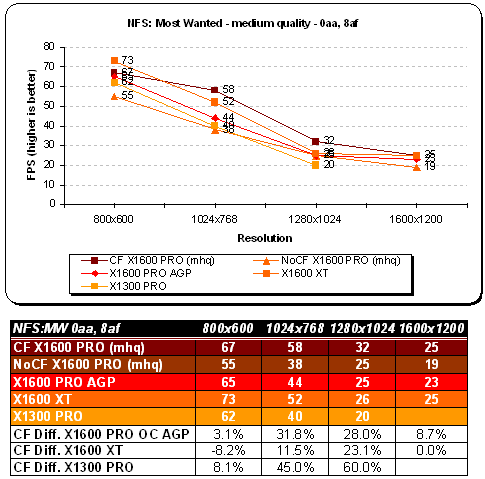
Noise
I’ve mentioned those two cards can be loud didn’t I? In 2D it’s operational and not so bad — unless you have some kind of cooking contest in your enclosure. Otherwise it’s bearable until you go into 3D where the heat is scorching and it gets quite messy. I haven’t thought that two X1600 would produce that much noise with those two “little” fans, but I guess it’s quite possible. I’m actually wondering if X1800 / X1900 in Crossfire will lift up your box and fly out your window…
Conlusions
Considering I’ve ran my CPU in default state where as X1600 XT and X1300 used OC’ed CPU it’s hard for me to judge exact performance increase and differences. I’ve experienced too many issues trying to make this comparison as much as apples-to-apples. It’s not so much the cards, but the motherboard was giving me a rough time. All in all, it’s quite easy to see the difference between single and Crossfire. In some cases it’s significant and in others it’s less. Also, the boards come with standard clocks — OC versions would be something that would boost Sapphire’s popularity in mid-end region.
With no need for master card, this solution may be good for those seeking less expensive graphics parts and no additional bonding media such as compositing cable. I, however do not recommend the board I was testing those samples on simply because it doesn’t seem ready and as for overclocking, it’s close to nonexistent so use it if you do not wish to OC your CPU and memory.
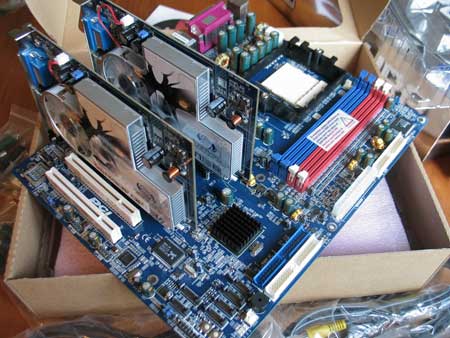
+ No compositing cables required
+ Rather cheap
+ AVIVO
+ Ok performance, nothing special
Cons:
– Two cards quite loud
– Sapphire motherboard flaky with G.Skill RAM
– Sapphire motherboard won’t OC
Sapphire X1600 PRO Crossfire gets the rating of 8.0 (Very good) out of 10 and the Bjorn3D Seal of Approval
 Bjorn3D.com Bjorn3d.com – Satisfying Your Daily Tech Cravings Since 1996
Bjorn3D.com Bjorn3d.com – Satisfying Your Daily Tech Cravings Since 1996











